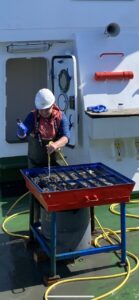Graduate student discovers earlier evidence for complex animal behaviors
Graduate student in Earth and Environmental Sciences Kat Turk recently published a paper about life in the Ediacaran. Along with her advisor, assistant professor Simon Darroch, and colleagues at the University of Toronto, Mississauga, she found we might need to change when we believe some complex animal behaviors evolved.
Predatory behavior may have arisen earlier than previously thought. According to Turk, we don’t have a firm date on the first appearance of predation or when it really became wide-spread. Fossils from the Cambrian Period appear to show strong evidence of predation, so we know it was around by this time. Turk’s research shows predation may go back even further.
According to Turk, “finding ecdysozoan trace fossils in the late Ediacaran means we probably had some level of active predation occurring during this interval. While priapulids today are not major predative players in benthic marine ecosystems, in the Cambrian they were some of the earliest apex predators, with individuals found with preserved gut contents including other priapulids and hard, shelly organisms that would have been a challenge to digest.”
Priapulids are worm-like animals that dig into the sediment and create holes. Before they evolved, the seafloor was predominantly covered with microbial mats. Their behavior of digging into the substrate may just put them in a class with beavers. Beavers are known as ecosystem engineers, as their behavior can change the landscape completely.
In the case of the priapulids, Turk explained, “they are like taking a hoe to an undisturbed plot of land – introducing that mechanical disruption results in aeration and makes the soil more hospitable for other organisms to develop.”
 She continued, “I do think the gradual evolution of these bioturbators probably correlated with a slow decrease in matground cover, as their initial and then later more aggressive burrowing would have disrupted matground structural integrity and broken it into smaller and smaller pieces as time went on.”
She continued, “I do think the gradual evolution of these bioturbators probably correlated with a slow decrease in matground cover, as their initial and then later more aggressive burrowing would have disrupted matground structural integrity and broken it into smaller and smaller pieces as time went on.”
These fossils are found in an area of desert located in Namibia. The Namib Desert is full of hills, canyons, and relatively flat rock areas. Due to a lack of tectonic movement in the area and lack of human intervention due to desert-conditions, the fossils – that once covered a seafloor – have remained undisturbed through time.
Darroch added, “due to some fortunate quirks of geology and Earth history the sediments have been subject to remarkably little faulting and deformation in the ~540 million years since they were deposited, meaning that – in many places – you can almost wander across the landscape and imagine you’re in an exhumed Ediacaran ocean.”
“The Nama Group of southern Namibia is the best place to find late Ediacaran fossils anywhere in the world – so much so that this interval and its organisms are collectively referred to as Nama-type,” explained Turk.

Darroch relishes the skills that Turk brings to the lab. “Kat brings a willingness to work with living organisms as a way to help interpret the fossil record, which is an extremely powerful approach. She brings ambition, an in-depth knowledge of modern burrowing organisms and their ecosystem engineering effects, and a profound (almost unsettling) love of worms,” he explained.
